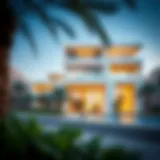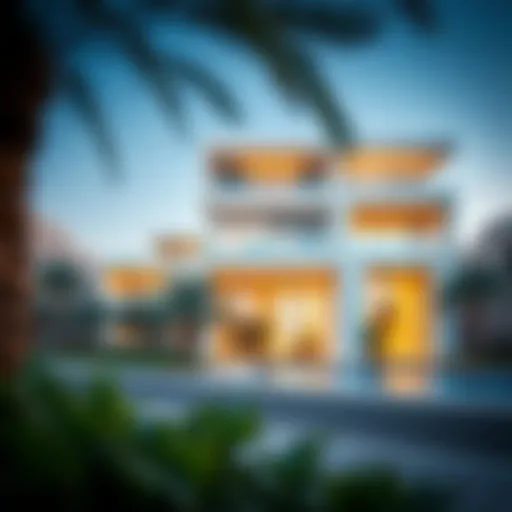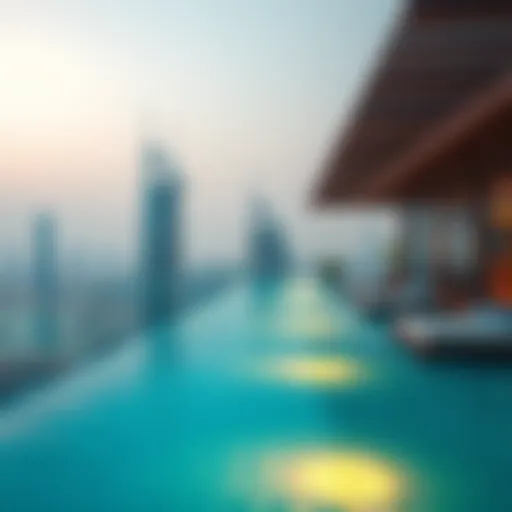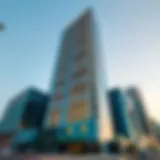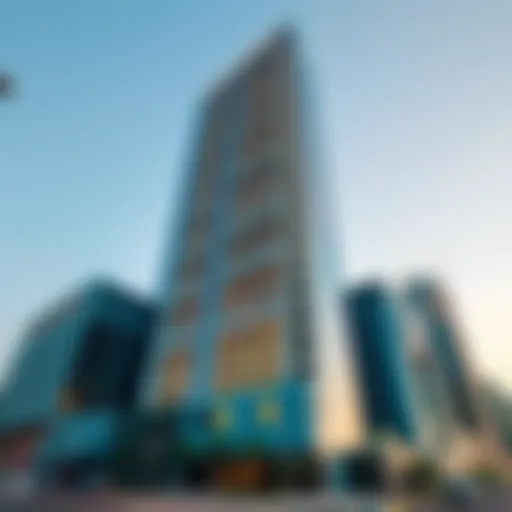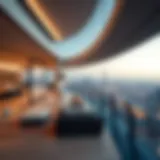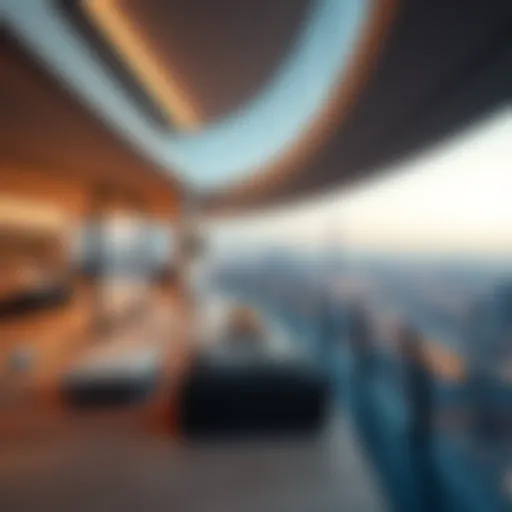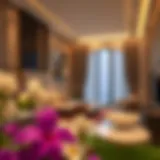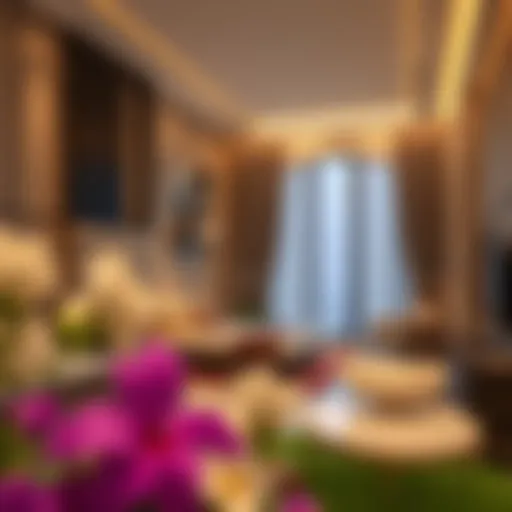Analyzing Phase One of the International City Project
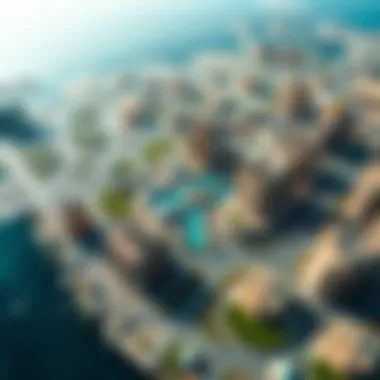
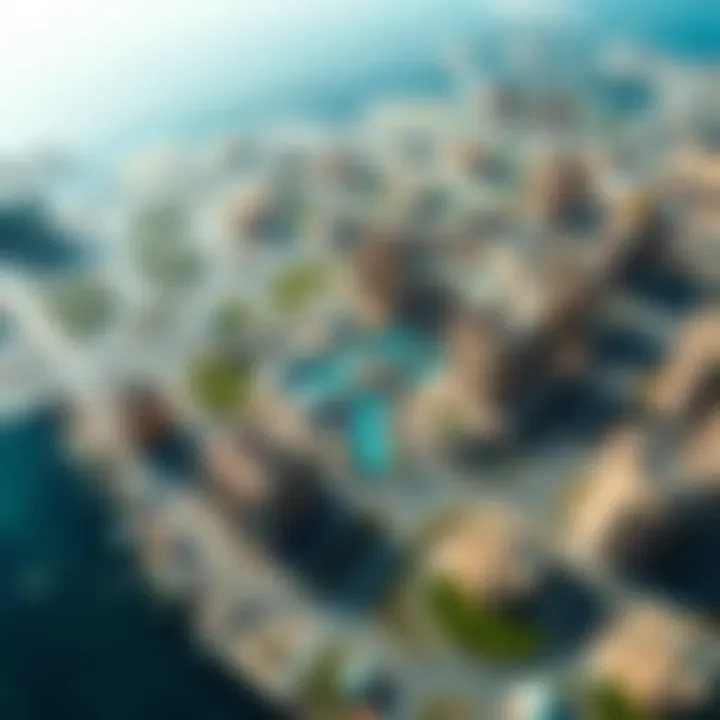
Intro
The International City project in Dubai is a landmark undertaking that has gained considerable attention in recent years. This sprawling development is not just a concrete jungle; it embodies an intricate blend of architectural ambition, cultural diversity, and urban planning. Understanding the project’s initial phase is crucial as it lays the groundwork for future expansions and sets the tone for Dubai’s real estate landscape.
As we embark on an exploration of this project, we'll delve into the specifics that shape its identity. From market trends to property types, each aspect contributes to a broader understanding of what the International City represents for investors, homebuyers, and real estate professionals alike. The goal is clear: to dissect the features of this ambitious project, highlight its implications for the local real estate market, and finally, illuminate the opportunities and challenges waiting just around the corner.
Market Trends
Analyzing the real estate market trends in Dubai is akin to reading tea leaves; it requires insight and an understanding of both immediate local phenomena and broader economic indicators.
Current Real Estate Trends in Dubai
Dubai's property market has been experiencing a renaissance of sorts. With an influx of international investors, confidence is slowly but surely building. The emirate has seen a significant upturn in demand for residential properties, particularly in areas near attractive amenities and transport links. Notably, Dubai's International City phase one offers both affordability and accessibility, making it a hot spot for both homebuyers and investors.
- Rising demand: A surge in expatriate populations is fostering a need for diverse housing options.
- Price stability: Contrary to previous years where prices dipped, the recent trend points towards stabilization, particularly in key areas.
- Investment opportunities: Many investors are eyeing the mixed-use potential of International City, making it an ideal prospect.
Future Forecasts for the Dubai Property Market
Forecasts are often painted with uncertainty, yet, one can clearly see recent patterns hinting at sustained growth. Market analysts suggest that Dubai will maintain its status as a real estate hotspot, supported by various governmental initiatives aimed at stimulating the economy. With the upcoming events, such as World Expo 2023, the International City development is perhaps at the right place at the right time.
"The growth in the real estate market reflects a broader recovery in the economy, with early indicators showing that values will stabilize."
Property Types
Understanding the types of properties within the International City project enriches potential investors' and homebuyers’ perspectives, allowing them to navigate their choices wisely.
Residential Properties: Overview and Insights
Residential offerings in phase one include a diverse range of apartments and villas designed with community living in mind. They cater to a spectrum of budgets, ensuring a wider reach among potential buyers.
Some characteristics of these properties include:
- Community-centric design: Emphasis on communal spaces and social engagement.
- Affordability: Competitive price points compared to other developments in Dubai.
- Diverse architecture: Inspired by various international styles, creating a vibrant living environment.
Commercial Properties: Opportunities and Challenges
On the commercial side, International City aims to attract businesses looking to capitalize on the growing consumer base in the surrounding areas. However, challenges loom in the form of competition from other commercial centers across Dubai.
- Opportunities: Proximity to residential areas provides a ready-made customer base.
- Challenges: Higher operational costs and the competitive market landscape may deter some businesses.
Navigating these nuances will be vital for stakeholders aiming to invest or engage with the International City Project. Investors must remain vigilant, as understanding market fluctuations and property types will ultimately determine success in this ever-evolving landscape.
Prelude to the International City
The International City project stands as a landmark undertaking in Dubai, illustrating the intricate blend of vision, ambition, and real estate development. This section serves as a critical starting point for understanding not only the architecture and design aspects of the project but also its broader implications within the context of Dubai's ever-evolving urban landscape. From the outset, it’s essential to appreciate how this project aligns with the Emirate's strategic goals to accommodate a growing population and enhance its global standing as a business and tourism hub.
Overview of the Project
The International City is more than just a collection of buildings. It represents a comprehensive approach to creating a vibrant community that reflects the diverse cultures of its residents. Designed to integrate living, working, and recreational spaces, the layout prioritizes accessibility. The concept stems from a realization that urban planning must evolve to deal with the influx of residents and tourists alike. The initial phase focuses on constructing clusters that capture various architectural styles from around the world, ensuring that each area belongs to its cultural essence.
Key elements of the project include:
- Open Spaces: Parks and community gardens are woven throughout the development to foster community interaction.
- Residential Units: A range of properties designed to appeal to different demographics, from single professionals to families, which encourages a mixed community.
- Commercial Areas: Retail spaces that cater to both residents and visitors, contributing to local economic growth.
- Transport Links: Well-planned roads and public transport connections aim to enhance mobility and reduce congestion, aligning with environmental considerations and sustainable urban design.
In essence, the International City project seeks to embody the Emirati spirit of welcoming diversity through architectural expression, thereby playing an essential role in Dubai's growth narrative.
Significance in the Dubai Real Estate Sector
The advancement of the International City is a notable landmark in the rapidly changing real estate landscape of Dubai. Understanding its significance requires a closer look at several factors that impact the local market. As competition for space intensifies, the project's strategic positioning about vital amenities and urban centers has made it a hot spot for investors, homebuyers, and developers.
The project contributes to a few key trends:
- Affordable Housing Options: Dubai has often been criticized for its luxury-oriented market, but International City strikes a balance, presenting opportunities for middle-income families and professionals.
- Cultural Integration: By mirroring global architectural styles and promoting a multicultural environment, the project attracts expatriates, which enhances Dubai's reputation as a global hub.
- Investment Potential: Investors see promise here, given the projected economic growth of the region. The demand for rental apartments is likely to rise, making it a lucrative option for property owners.
- Regulatory Framework: The support from local authorities for initiatives like this also provides a sense of security to investors, making the property development landscape more inviting.
In summary, the International City isn't just a project; it represents a paradigm shift in how Dubai approaches real estate development, ensuring long-term growth and sustainability while appealing to a diverse array of stakeholders. Through this lens, the intertwining of community and commerce becomes apparent, revealing the essential role that good urban planning plays in realizing Dubai’s vision for the future.
"Urban planning is more than creating spaces; it’s about crafting environments that nurture communities and foster growth."
This exploration into the International City project serves as a foundational entry point for understanding how such initiatives can concurrently enhance the quality of life and stimulate economic opportunity in one of the world’s fastest-growing cities.
Historical Context of the Development
Understanding the historical context of the International City project is essential for grasping its wide-ranging impact on Dubai's urban landscape and real estate framework. The evolution of this massive initiative can be traced through its initial concept and the key milestones that have shaped its progression. This context not only sheds light on the current state of the development but also outlines the aspirations that have driven it forward, thus making it invaluable for investors, homebuyers, and developers alike.
Initial Concept and Vision
The vision for International City emerged in the early 2000s, amidst a period of rapid urbanization in Dubai. The concept was born from a desire to create a diverse and self-sustaining community that could accommodate a multifaceted lifestyle. With this ambition, the project aimed to foster a blend of residential, commercial, and leisure spaces, contributing to a holistic lifestyle that residents and visitors alike could embrace.
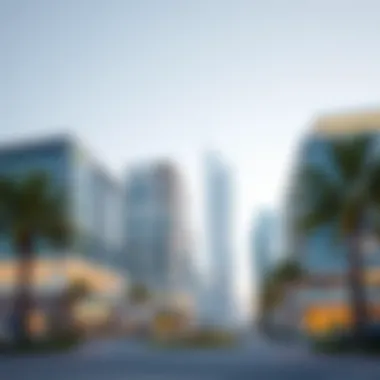
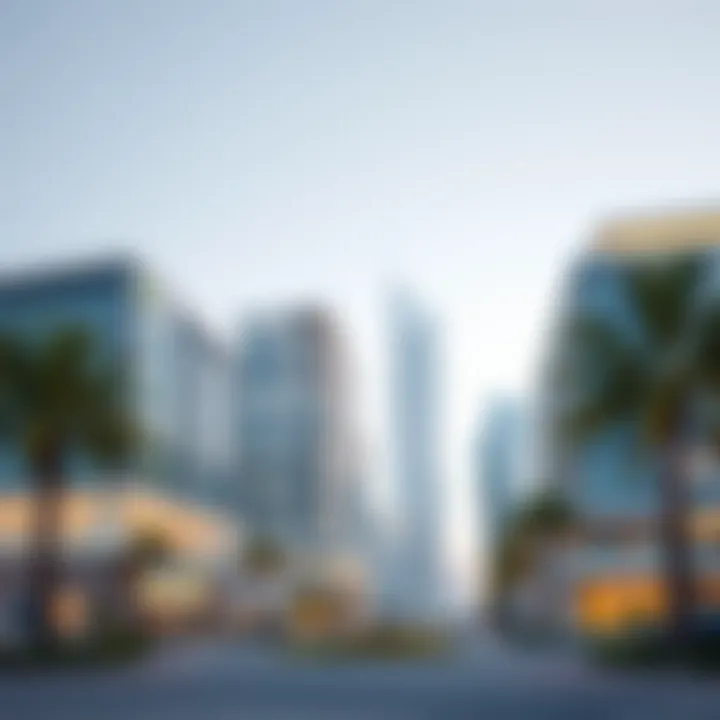
One distinctive aspect of the project's initial vision was its emphasis on internationalism. The idea was to represent various cultures through architecture and urban design, embodying a global spirit that aligns well with Dubai's identity as a melting pot of nationalities. Imagine a locale where each zone takes cues from global architectural styles— for instance, an Italian plaza juxtaposed against Asian-inspired residential blocks. This approach served as a magnet for diverse communities, drawing in a tapestry of residents eager to partake in a microcosm that reflects their experiences from around the world.
Key Milestones in Development
The journey of International City has been marked by several pivotal milestones that stand testament to its ambitious scope. Initially, the groundwork began in 2002, with the project launching into heavy construction phases shortly thereafter. A handful of key developments took precedence during these formative years:
- 2003: The first phase of construction began, focusing on infrastructure development. Roads, utilities, and foundational elements were put in place to support the planned communities.
- 2004: The introduction of the "residential clusters" was a significant development milestone. These clusters were designed to group homes by cultural themes, encouraging community interaction among like-minded individuals.
- 2006: The completion of the initial residential units signified a monumental moment in the project. This allowed early residents to move in, setting the stage for future expansion and community development.
- 2008: The unveiling of community amenities— parks, commercial outlets, and recreational areas—turned the spotlight on the lifestyle aspect of International City, showing just how much the vision had taken shape.
"The development of International City was not just to build homes but to create a vibrant community that lives and breeds culture."
This series of milestones reveals the evolution of a grand vision into a functional space that began attracting a variety of inhabitants and businesses. Each phase built on the previous efforts, crafting a cohesive narrative that reflected not just the needs of the time, but also a long-term vision for community living in Dubai. Investors can discern the potential of International City not merely through market trends but by understanding the thoughtful planning that has characterized its development through the years.
This historical overview establishes a solid base for further exploration into the architectural and design features, location advantages, demographic nuances, and investment opportunities presented by Phase One of the International City Project.
Architectural and Design Features
The architectural and design features of the International City project are crucial in shaping not only the aesthetic but also the functional aspects of this sizable development. These features are pivotal in attracting investors and residents alike, offering a blend of innovative design and practical considerations that reflect the modern urban philosophy of Dubai. The success of such an ambitious project hinges significantly on how well these elements come together, creating appealing environments that resonate with the values and needs of the future stakeholders.
Urban Planning and Layout
Urban planning plays a critical role in the International City project. The layout is meticulously designed to promote connectivity and accessibility, which are key for both commercial and residential spaces. Walking paths and bike lanes are integrally woven into the design to encourage eco-friendly transportation options. The thoughtful arrangement of spaces takes into account the need for communal areas, recreational facilities, and commercial hubs, ensuring that the project does not merely serve as a collection of buildings but as a vibrant community.
To illustrate the significance of a well-planned urban environment:
- Accessibility: Key roads and public transport links are strategically placed to reduce congestion and enhance mobility. This ensures seamless travel to and from the area, making it a desirable location.
- Zoning: A diverse array of zoning categories allows for a mix of residential, commercial, and recreational areas, establishing a balanced lifestyle. Thus, residents have essential amenities close at hand, such as parks, shops, and cultural centers.
- Green Spaces: Incorporating green belts and parks into the urban plan not only beautifies the area but also contributes to improving residents' quality of life.
This holistic approach to urban planning positions International City as a forward-thinking project that prioritizes community over individual units.
Architectural Styles and Influences
The architectural styles found within the International City project reflect a rich tapestry of cultural influences, serving to celebrate the diversity of Dubai itself. While modern architecture often leans towards sleek lines and minimalism, the International City's designs incorporate various elements that pay homage to traditional Middle Eastern aesthetics while still pushing the envelope with innovative construction techniques.
- Cultural Influences: The complex draws inspiration from a variety of architectural traditions, seamlessly integrating elements from Islamic design, which is renowned for its intricate geometric patterns and ornate details. This gives the spaces a unique character that feels both modern and timeless.
- Sustainable Design: The buildings are designed with sustainability in mind. This includes energy-efficient systems and materials that minimize environmental impact while offering long-term cost savings for owners and tenants.
- Functionality: An emphasis is placed on creating functional layouts that maximize space utility. Open floor plans and large windows not only optimize natural light but also create inviting environments that can adapt to various uses.
"In architecture, the fabric of a building becomes as much a part of its environment as the surrounding landscape. The International City project aims to blend these elements seamlessly, making the architecture a key player in urban harmony."
In summary, the architectural and design features of the International City project are more than mere visual elements. They function as a backbone to the entire development strategy, enhancing the quality of life for residents while aligning with global trends toward sustainability and cultural integration. Through a sound framework, investors can find assurance that the project holds potential for long-term value and community enrichment.
Further Reading on Urban Planning
Learn about Sustainable Architecture
Community Planning Resources
Location and Accessibility
Location and accessibility form the core foundation for any real estate development. In the context of the International City project in Dubai, these elements take on added significance due to the ambitious scale and aims of this venture. A prime location can significantly bolster property values and enhance the quality of living, which is exactly what the architects and planners envisioned for this initiative.
Accessibility considerations go hand in hand with location. The shorter the distance to essential services and amenities, the more desirable a property appears to potential buyers and investors. In this regard, the International City scores high due to its strategic positioning within the emirate.
Proximity to Key Amenities
When evaluating the potential of any real estate project, proximity to key amenities is a major deciding factor. The International City is not just about stunning architecture and expansive layouts; it’s also about creating a community where residents have everything they need at their fingertips.
- Shopping Centers and Markets: The development is situated close to various commercial hubs, providing easy access to shopping malls and traditional markets, ensuring that daily needs are met conveniently. For instance, the Dragon Mart, known for its vast array of products ranging from home goods to electronics, is merely a stone's throw away.
- Educational Institutions: Families tend to flock to neighborhoods with quality education. The proximity of well-regarded schools and universities can significantly influence property desirability. The International City is relatively close to several top-rated educational institutes.
- Healthcare Facilities: Healthcare is paramount for residents, and the nearby hospitals and clinics offer peace of mind, enhancing the attractiveness of the location. Having accessible medical facilities ensures that residents won’t need to travel far in case of emergencies.
- Recreation and Leisure: Parks, playgrounds, and leisure facilities add a layer of comfort and engagement for residents, making the community more vibrant. Access to green spaces allows for outdoor activities, promoting a healthy lifestyle.
Transportation Infrastructure Development
One cannot underestimate the role of transportation infrastructure. The ease with which one can navigate to and from the International City can make or break its appeal. Current developments illustrate a clear commitment to enhancing transportation linkages.
- Road Connectivity: Key highways like the Sheikh Mohammed Bin Zayed Road and the Al Awir Road facilitate efficient commuting to various parts of Dubai. This strategic positioning means that reaching the main hubs—such as the Dubai International Airport or the Downtown area—is both quick and straightforward.
- Public Transport Options: Upcoming developments include expanding public transport corridors. Future plans for metro extensions and bus routes will provide invaluable connections, catering especially to those who prefer not to drive.
- Cycling and Walking Paths: An often-overlooked aspect of urban development is pedestrian and cyclist accessibility. With integrated pathways, the International City aims to encourage healthier ways to get around, making it a modern and appealing locale.
"Location isn't just where you live or work – it's a strategy that influences your lifestyle and choices daily."
For further insights into Dubai's real estate landscape, explore resources at Wikipedia or Britannica.
Remember, investing in a location like the International City could offer significant returns as these amenities and connectivity continue to evolve.
Explore more about the unique positioning of the International City at Reddit and local governmental resources.
The Demographic Landscape
Understanding the demographic landscape is essential when evaluating the International City Project in Dubai. This aspect encompasses the characteristics and behaviors of the target audience, which can significantly impact investment decisions, property developments, and urban planning. With a carefully analyzed demographic profile, stakeholders can tailor their offerings to the needs and preferences of potential residents and investors. This section will highlight several significant elements related to demographics, such as targeted population segments and evolving consumer preferences.
Target Population Segments
The International City Project aims at attracting diverse groups of inhabitants, each with unique requirements and aspirations. Key segments include:
- Young Professionals: Attracted by affordable housing and access to commercial hubs, this group is often looking for vibrant lifestyles and modern amenities.
- Families: These residents seek safety, educational facilities, and recreational opportunities. The design of family-friendly spaces within the project is vital to their appeal.
- Expats and Foreign Nationals: Dubai is a melting pot of cultures, and this segment often seeks community-oriented environments with relatable amenities. Features catering to diverse cultures can be beneficial.
- Investors: Investors, both local and international, are drawn by potential returns on investments. Properties catering specifically to their needs can play a crucial role in the overall success of the project.
This wide array of target segments facilitates a well-rounded community, while also enabling a sustainable ecosystem of buyers and tenants. Understanding the preferences and needs of these groups is vital for any development strategy.
Consumer Preferences and Behaviors
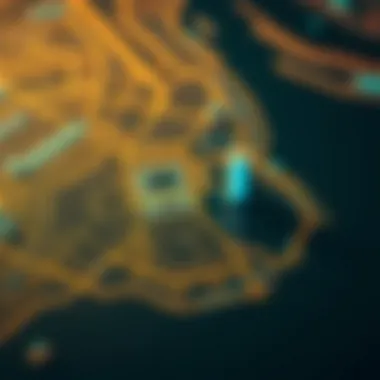

The preferences of potential buyers and renters in the International City showcase an evolving marketplace. For instance, there is a growing demand for mixed-use developments that foster community engagement. Key trends observed include:
- Sustainability: Many consumers are increasingly prioritizing environmentally friendly living options. Developments that incorporate green spaces and energy-efficient designs are seen as more attractive.
- Cultural Relevance: The cultural diversity of Dubai means that developments that reflect various cultural influences can enhance emotional resonance with residents. As a result, properties that celebrate local and international cultures can draw significant interest.
- Technological Integration: There’s a rising expectation among consumers for smart home capabilities and integrated technology in properties. This desire can influence property valuations and investment attractiveness.
- Flexibility in Space: Preferences for adaptable living spaces that can cater to remote working or mixed-use living are gaining traction. Providing flexible layouts can enhance the appeal of properties to potential residents.
"A thorough understanding of demographic trends can make or break an investment strategy in real estate. It's not just about selling properties; it's about creating communities that resonate."
Market Trends and Property Valuations
Understanding the Market Trends and Property Valuations of the International City project is essential for anyone considering investment or relocation in Dubai. Each trend reveals how the market is shifting and reflects the evolving dynamics of the real estate landscape. Through this examination, we can gauge the investment potential and evaluate risks involved.
Real estate investment is a multifaceted domain. Investors need to appreciate factors like demand, supply, and economic influences that contribute to property valuation. In Dubai, where expectations are sky-high, even subtle changes can have significant impacts on prices and investments. This section aims to showcase those nuances, helping potential stakeholders to navigate the complex terrain of property in the International City.
Current Market Analysis
As of recent reports, the International City has exhibited a blend of optimism amidst the fluctuating economy. Price stability has manifested in specific areas while others have seen a slight decline. Awareness of these trends is paramount:
- Strong rental demand: With affordable housing options, many expatriates find this location attractive.
- Diverse property types: From studios to larger apartments, there’s variety to cater to different segments of the population.
- Economic recovery signs: The aftermath of the pandemic shows a gradual rebound not just in Dubai but in the overall UAE real estate sector.
"Market fluctuations should not only be seen as hurdles but are often the foundation for long-term investment strategies."
Pricing-wise, as areas surrounding the International City develop—like the new malls and infrastructure—there’s a ripple effect that can elevate property values. Buyers here witness a favorable return on investment, particularly when compared to emerging hotspots in the region.
Predictions for Future Growth
Looking towards the horizon, we can identify several catalysts for growth in the International City. Here’s what you might want to keep on your radar:
- Infrastructure expansion: Continued investments in public transportation and amenities will enhance connectivity and desirability.
- Increased expatriate population: The growing number of workers looking for affordable housing is likely to keep demand resilient.
- Positive economic sentiment: Government policies aimed at boosting investments and easing regulations are favorable.
- Sustainability initiatives: A focus on environmentally friendly developments may attract a growing demographic looking for sustainable living options.
As we peer into the future, signs suggest that properties will maintain or increase their values over time as the city continues to expand. However, it’s crucial for investors to remain vigilant, assessing both short-term risks and long-term opportunities.
Investment Opportunities in Phase One
Investing in the first phase of the International City project brings forth a plethora of opportunities that can cater to a diverse array of investors, from seasoned real estate magnates to new homebuyers hopeful for the future. With its unique positioning in the Dubai market, the project is tailored not just to meet housing needs, but also to provide a robust investment avenue imbued with potential for substantial returns.
The significance of this investment landscape lies in a few crucial areas. First off, the diverse property offerings cater to different markets. Buyers can choose from residential apartments, commercial spaces, or even mixed-use developments that foster a vibrant community atmosphere. These varied options appeal directly to a multitude of potential tenants, which in turn can guarantee a steady inflow of rental revenue for investors.
Moreover, the location advantage cannot be overlooked; placed strategically with access to major road networks, residents can enjoy both urban convenience along with a community ambiance. With infrastructure improvements already underway, this can only bolster property values further.
Types of Properties Available
Within this first phase, the International City project hosts an eclectic selection of properties:
- Residential Apartments: A blend of studio, one-bedroom, and two-bedroom flats designed to cater to both small families and singles. Each unit comes with modern amenities, ensuring comfort and functionality.
- Commercial Units: Designed to attract businesses aiming to tap into the diverse consumer base, these properties are versatile, allowing for retail shops, offices, and service-oriented establishments.
- Mixed-Use Developments: Integrating living spaces with commercial opportunities, these developments foster a multifaceted community environment, creating synergy among residents and businesses alike.
For investors, this mixture means there’s something to suit their strategic objectives, whether they are looking for long-term capital growth or immediate rental returns.
Financing Options for Investors
Diving into the financial aspects, potential investors should be aware of various financing avenues that can facilitate their investment in International City. Here’s a breakdown of what’s on offer:
- Traditional Mortgages: Local banks and financial institutions provide mortgage options to help buyers finance their purchases. This is ideal for individuals or families wanting to own property without a hefty upfront cost.
- Developer Financing Plans: Many developers offer payment plans that allow buyers to pay in stages throughout the construction period, easing the financial burden.
- Investment Groups: For those who prefer to invest in a collective manner, pooling resources with other investors through real estate investment groups can serve as an effective strategy.
- Equity Financing: Investors can also consider raising funds through equity financing, bringing in partners who share the investment risk and rewards.
It's paramount to analyze each avenue thoroughly. Understanding the implications, responsibilities, and potential returns tied to different financing options can provide a clearer path forward.
“Investing in a thriving, developing community brings not just returns, but the sense of being part of something bigger.”
Challenges Facing the Project
The International City project, while ambitious and potentially transformative, is not without its hurdles. Challenges impact various dimensions of the project, from financial stability to regulatory compliance. Understanding these challenges is crucial for investors, homebuyers, agents, analysts, and developers, as they shape the viability and sustainability of the development.
Economic Fluctuations and Their Impact
The real estate market is inherently cyclical, influenced by a variety of economic factors. Economic fluctuations can make or break a project like International City. A downturn in the economy or a dip in consumer confidence can lead to reduced demand for properties, which ultimately can affect pricing, financing options, and the project’s timelines. The fluctuating oil prices, currency values, and inflation can create a ripple effect, triggering a domino of changing investment appetites.
Consequently, should an economic downturn hit during any phase of development, it could lead to reduced profitability. The long-term success of this project hinges on appropriate economic forecasts, responsive strategies, and mitigative measures that stakeholders must devise to navigate the market's unpredictability. Investors, for instance, must consider diversifying portfolios to cushion against downturns while maintaining keen insight into local economic trends.
Regulatory and Compliance Issues
Navigating the regulatory landscape is a key challenge for the International City project. The requirements imposed by local government bodies can be stringent and multifaceted. Regulations often encompass zoning laws, environmental impact assessments, and building codes. Failing to adhere to these rules may not just delay phases of the project but could also result in legal repercussions and financial losses.
The approval process can sometimes lay in limbo due to lengthy bureaucratic procedures or shifting compliance standards. Consequently, developers must remain informed and adaptable, ensuring all facets of the project are compliant at every stage. This complexity can pose a barrier for potential investors, who may find the need for extensive legal advice an added challenge on top of other financial risks.
Community Development Initiatives
Community development initiatives are critical in shaping the success and sustainability of the International City project. These efforts focus on enhancing social and physical infrastructure, thereby facilitating a harmonious living environment that meets the needs of future residents and investors alike.
Social Infrastructure and Amenities


One of the primary aspects of community development is the establishment and enhancement of social infrastructure and amenities. This involves creating facilities that promote social interaction, well-being, and quality of life. In the case of the International City project, a variety of communal spaces such as parks, recreational areas, and community centers are vital. These areas not only serve as gathering spots for residents but also foster a sense of belonging.
Investors should take note of the following considerations:
- Healthcare Facilities: Access to hospitals and clinics ensures residents' health and safety, adding a layer of appeal for potential buyers.
- Educational Institutions: Proximity to schools and universities is a significant draw for families looking to settle long-term.
- Retail and Entertainment Options: Establishing shopping centers, movie theaters, and cultural venues keeps the community vibrant and promotes local business engagement.
Investing in these amenities not only satisfies the immediate needs of the community but also increases property value over time.
Engagement with Local Residents
Engaging local residents in community development initiatives is paramount. Active involvement can turn constituents into stakeholders, fostering loyalty and a strong community spirit. The engagement practices include:
- Public Consultations: Inviting residents to share their views and expectations about the development helps to align the project with their needs.
- Feedback Mechanisms: Implementing platforms for ongoing dialogue allows residents to express concerns and suggestions, which can be addressed in real-time.
- Community Events: Organizing events such as cultural festivals or neighborhood clean-ups strengthens community bonds and encourages participation.
By prioritizing resident engagement, the International City project can cultivate a constructive environment where individuals feel heard and valued. This approach maximizes social capital, ultimately contributing to the area's long-term success.
"A community is only as strong as the bonds that tie its members together; hence, their involvement is not just a benefit but a necessity for the prosperity of the International City project."
To conclude, community development initiatives serve a multitude of purposes in the International City project, enhancing quality of life and fostering an inviting environment. Investors, homebuyers, and developers alike should view these initiatives as key indicators of the project's viability and potential for appreciation.
Environmental Considerations
The environmental aspects of the International City project are not just an afterthought; they are woven into the very fabric of the planning and execution phases. With urban development often being at odds with nature, the project must tread carefully to strike a balance. Recognizing the importance of sustainability has become paramount for developers, investors, and the local community alike. The implications of environmental considerations extend beyond immediate aesthetic appeal; they shape future interactions with the city, influence public perception, and ultimately affect property values.
Sustainable Design Practices
Sustainable design practices lie at the heart of the International City project. This movement aims to minimize the ecological footprint while maximizing social and economic returns. The project has integrated several key practices:
- Energy Efficiency: Buildings are designed to utilize natural light and ventilation, reducing reliance on artificial lighting and climate control. This not only cuts down on energy consumption but also enhances inhabitants' overall well-being.
- Water Conservation: Utilizing smart irrigation systems and water-efficient fixtures ensures that water use is minimized. This is especially crucial in a region like Dubai, where fresh water is a precious resource.
- Material Selection: The choice of environmentally friendly materials in construction processes helps mitigate waste and reduces the carbon footprint. By opting for recycled and locally sourced materials, the project supports sustainability efforts beyond the construction phase.
These design principles are not simply boxes to tick for compliance. On the contrary, they reflect a deeper commitment to a vision where future generations can thrive in a city that promotes harmony between urban living and nature.
Impact on Local Ecosystems
The impact of the International City project on local ecosystems cannot be understated. Every move made during its development has the potential to significantly disturb native flora and fauna. Thus, conducting thorough ecological assessments prior to construction is essential. Here are some potential impacts:
- Habitat Disruption: Construction activities can displace local wildlife, potentially leading to adverse effects on biodiversity. Efforts must be made to identify and preserve critical habitats before development starts.
- Air Quality Concerns: Increased construction and future vehicular traffic can lead to air pollution, affecting both human health and local ecosystems. Employing strategies to limit emissions, such as promoting public transport, could help alleviate these issues.
- Water Runoff and Pollution: Development might also exacerbate water runoff issues, leading to pollutants flowing directly into local waterways. Implementing green spaces and permeable surfaces can alleviate such problems by promoting natural water absorption.
"Being proactive about environmental impact is not just good policy; it's good business. Future value depends on sustainable practices today."
In summary, acknowledging and addressing environmental considerations in the International City project isn't just a regulatory necessity - it’s a pathway to ensure a sustainable future. Investors, homebuyers, and stakeholders should pay attention to these elements, as they not only reflect the project's current ambitions but also set a precedent for ongoing development in the region.
Future Vision for International City
The future vision for the International City project stands as a cornerstone in understanding its trajectory and significance within Dubai's ever-evolving real estate landscape. This vision not only encompasses the physical development of infrastructure and buildings but extends to social, economic, and environmental dimensions that aim to create a sustainable urban environment. As we look ahead, several specific elements and benefits of this vision emerge, defining the project and its potential long-term impact on its residents and investors alike.
Future Phases and Developments
As Phase One concludes, the anticipation brews for subsequent phases, which promise to expand the scope and capabilities of International City. Each phase is strategically planned to incorporate new elements that respond to the evolving needs of the community. Here are some key highlights:
- Mixed-Use Developments: Upcoming phases aim to introduce a mixture of residential, commercial, and recreational spaces, providing a holistic living experience. This blend ensures accessibility to essential amenities, catering to a diverse demographic.
- Smart Technology Integration: As smart cities become more prevalent, the application of cutting-edge technology in construction and infrastructure is set to enhance connectivity and efficiency.
- Green Spaces: Future developments will prioritize parks and open areas. Not only do they beautify the landscape, but they also promote well-being and community engagement.
Long-term Urban Planning Goals
The long-term planning goals associated with International City are essential to its success and sustainability. Investors, homebuyers, and developers have a vested interest in these philosophies:
- Sustainability Focus: The goal is to create an environment that promotes sustainable living through energy efficiency, water conservation, and waste management strategies. Future construction will emphasize eco-friendly materials and practices.
- Community-Centric Design: Urban planning will shift towards designs that promote social interactions. Community centers, schools, and healthcare facilities will be woven into the fabric of the urban area, fostering stronger community ties.
- Transportation Efficiency: Enhancing transport links will remain a priority. Improved roads and public transport are in the pipeline to link residents easily to the wider Dubai area.
Future phases of the International City project will not just transform landscapes; they will also redefine the quality of life for its residents.
By maintaining a foresighted approach in both the development phases and long-term strategies, the International City project aims to be a beacon of innovation and sustainability. Investors and stakeholders can find assurance in these plans, indicating that the future of International City is not merely a promise but a well-structured pathway towards thriving urban living.
Ending
In concluding the discussion surrounding the initial phase of the International City project, it’s paramount to consider the multidimensional aspects that integrate into its overall significance. This phase is not merely a foundational block; it represents the linchpin of future aspirations and developments within Dubai’s expansive urban narrative. When examining the project as a whole, the lessons and observations derived from its first phase lay essential groundwork not only for real estate investment but also for broader urban planning initiatives.
The strategic location, cutting-edge architectural features, and pervasive community engagement evidenced in this phase are vital elements that inform the advantages investors can expect. These considerations illuminate how the project aligns with both local and international market trends, providing stakeholders with compelling insights into future potential. Furthermore, an investment in the International City is ostensibly an investment in the cultural and social fabric that Dubai continues to weave.
Potential investors and stakeholders must recognize that, while challenges abound—ranging from regulatory complexities to economic fluctuations—the calculated risks stem from opportunities as much as they do from inevitable hurdles. The foundational achievements of Phase One create a stable launchpad that not only serves current necessity but also anticipates future demands of an evolving urban landscape.
"In real estate, location capitalizes on the now, but it’s the vision that carves pathways to tomorrow."
In essence, the International City project stands as a beacon for what can be achieved through foresight, resilience, and commitment. As the project unfolds, continuous reassessment of its impact, learnings from its early development phases, and the shifting dynamics of the real estate market will be essential to harnessing its full potential.
Summary of Key Insights
- Strategic Location: The International City project occupies a prime area that enhances its appeal to potential buyers and renters alike. This not only fosters a vibrant community but also strengthens its foothold in the competitive real estate market.
- Architectural Innovation: The design elements not only offer aesthetic value but also reflect sustainable practices that resonate with modern preferences of buyers and investors.
- Investment Viability: The groundwork laid in Phase One showcases promises for substantial returns on investments, particularly given the projected growth in the region's real estate sector.
Final Thoughts on Investment Potential
The International City project presents a compelling case for investment, drawing interest from various stakeholders ranging from individual homebuyers to institutional investors. Key considerations include:
- Diverse Property Options: From residential to commercial spaces, the variety in property types opens doors for numerous investment strategies.
- Growing Demand: The influx of residents and businesses into Dubai underscores an increasing demand that bolsters property values over time.
- Forward-Thinking Infrastructure: The ongoing development of transportation and amenities enhances the long-term appeal of the project, promising a robust living and economic environment.
By critically evaluating these elements, it becomes clear that the International City project positions itself as not just a place to live, but as a strategic participant in Dubai's multifaceted growth trajectory.
